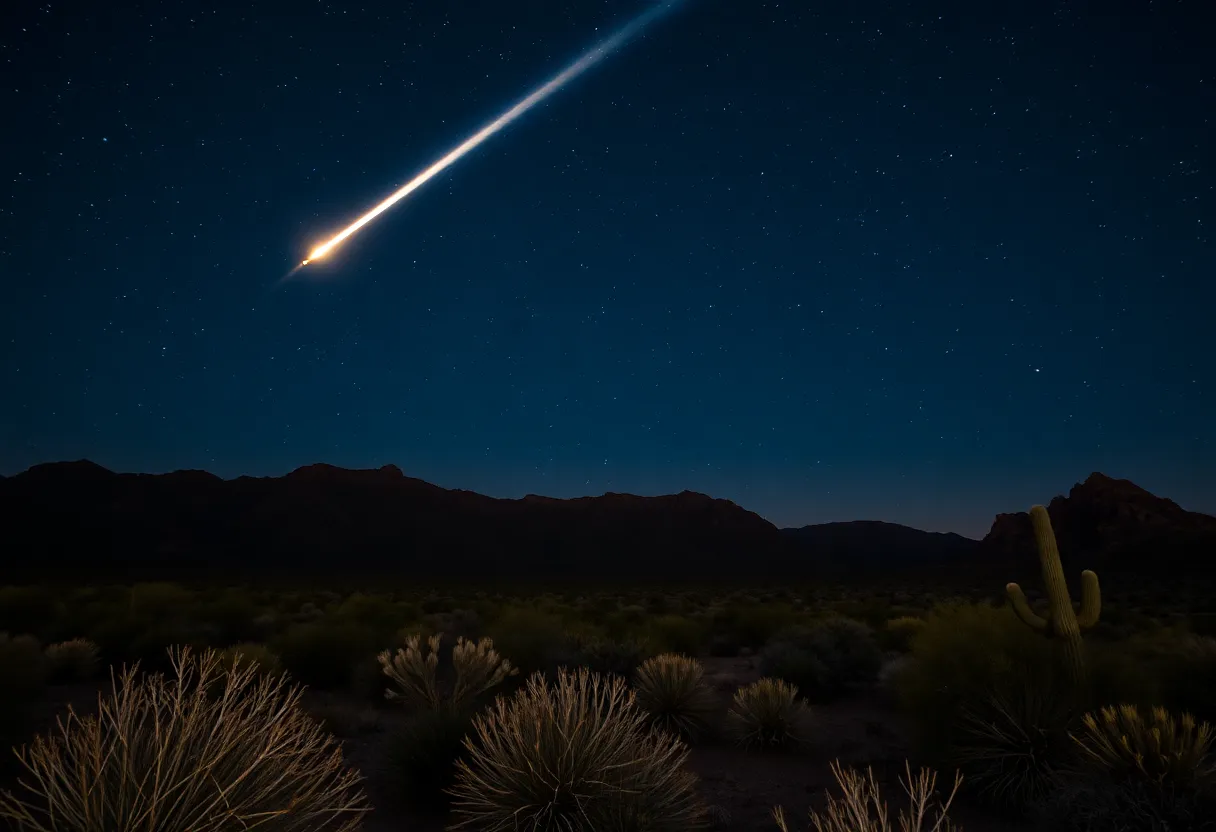Tucson, October 25, 2025
A newly discovered comet, C/2025 T1, has captivated Tucson’s skygazers during its recent appearance in the night sky. First spotted at Mount Lemmon Observatory, this comet offers a rare naked-eye view under the clarity of the region’s autumn skies. Visible for the next two weeks, it has drawn crowds of astronomy enthusiasts and families alike, turning routine evenings into exciting educational experiences about the wonders of the universe.
Tucson Welcomes Rare Sighting of Newly Discovered Comet C/2025 T1
Tucson, AZ – A newly discovered comet, first spotted from Mount Lemmon Observatory last week, captivated skygazers across the region early Saturday morning. Named C/2025 T1, the comet made a stunning appearance over Tucson skies, visible to the naked eye under clear desert conditions. This rare celestial event has sparked widespread interest among amateur astronomers and local residents, offering a brief window to witness the phenomenon before it fades from view.
The comet’s visibility is expected to last for the next two weeks, providing ample opportunity for skywatchers in the area. Experts note that C/2025 T1 stands out due to its brightness, making it accessible without telescopes for those in low-light pollution zones like the outskirts of Tucson. The sighting comes at an ideal time, aligning with the region’s dry autumn weather, which enhances viewing conditions post-sunset.
Local astronomy enthusiasts gathered at various vantage points around the city, from urban parks to remote desert spots, to catch a glimpse of the comet’s tail streaking across the evening sky. The event has not only drawn crowds but also encouraged families and individuals to engage with the night sky, turning a routine evening into an educational adventure. Reports indicate that the comet appeared as a faint but distinct glow low on the horizon, growing more prominent as darkness fully set in.
Discovery and Path of C/2025 T1
The comet was initially detected at the Mount Lemmon Observatory, a key facility for tracking near-Earth objects and cosmic visitors. Observers there identified the comet during routine scans, confirming its trajectory and brightness levels shortly after. C/2025 T1 is classified as a long-period comet, meaning it originates from the distant Oort Cloud and takes hundreds or thousands of years to orbit the Sun. This particular pass brings it close enough to Earth for visibility, a occurrence that happens infrequently for such objects.
Following its discovery, astronomers tracked the comet’s path as it approached the inner solar system. The visibility window began in earnest on Saturday, with the comet rising higher in the sky each night. By positioning itself against the backdrop of southern constellations, it becomes easier to spot for those facing away from city lights. The comet’s nucleus, surrounded by a glowing coma and dust tail, creates a picturesque display that has been compared to a cosmic brushstroke across the heavens.
Viewing Tips and Local Recommendations
To make the most of this event, professionals from the University of Arizona suggest heading outdoors after sunset, ideally between 7 p.m. and 10 p.m. local time. They recommend seeking elevated or open areas with minimal light interference, such as Mount Lemmon trails or the Tucson Mountains. Binoculars can enhance the view, revealing more details of the tail, though the comet remains visible unaided to the eye.
Clear skies are forecasted for the coming days in Tucson, minimizing cloud cover that could obscure the sight. Those new to stargazing are advised to use free astronomy apps to locate the comet’s position relative to familiar stars. This event underscores the accessibility of space phenomena, bridging the gap between professional research and public curiosity.
Broader Impact on Community Interest
The arrival of C/2025 T1 has revitalized interest in astronomy within Tucson, a city already rich in cosmic observation history thanks to its proximity to major observatories. Schools and community groups are incorporating the comet into impromptu lessons, highlighting how such events can inspire the next generation of scientists. The comet’s passage serves as a reminder of the vastness of space and the ongoing discoveries happening right in Arizona’s backyard.
As the two-week viewing period progresses, residents are encouraged to share their experiences safely, avoiding off-road driving at night. This natural spectacle not only entertains but also educates, fostering a deeper appreciation for the universe and the role of local institutions in unveiling its wonders.
Historical Context of Comet Sightings
Comets like C/2025 T1 have long fascinated humanity, often appearing as harbingers in ancient cultures. In modern times, discoveries from sites like Mount Lemmon Observatory contribute to global databases, aiding predictions of future visits. This comet’s naked-eye visibility is particularly special, echoing famous passages like Halley’s Comet but on a rarer scale for contemporary observers. The event’s timing in Tucson amplifies its significance, given the region’s optimal conditions for celestial viewing year-round.
In summary, the stunning appearance of C/2025 T1 marks a highlight for Tucson’s night sky in 2025, blending scientific achievement with communal joy. With two weeks ahead, the city braces for continued wonder under the stars.
FAQ
- What is the name of the comet visible over Tucson?
- C/2025 T1
- Where was the comet first spotted?
- Mount Lemmon Observatory
- When did the comet make its appearance over Tucson skies?
- Early Saturday
- How long will the comet be visible?
- For the next two weeks
- What do experts recommend for viewing the comet?
- Viewing it post-sunset in clear desert skies
- Who provides recommendations for viewing?
- Experts from the University of Arizona
- What makes this comet sighting special?
- It offers a rare naked-eye view
Key Features of Comet C/2025 T1
| Feature | Details |
|---|---|
| Name | C/2025 T1 |
| Discovery Location | Mount Lemmon Observatory |
| First Sighting Date | Last week |
| Appearance Over Tucson | Early Saturday |
| Visibility Duration | Next two weeks |
| Viewing Method | Naked-eye view |
| Recommended Viewing Time | Post-sunset |
| Ideal Conditions | Clear desert skies |
| Expert Affiliation | University of Arizona |




